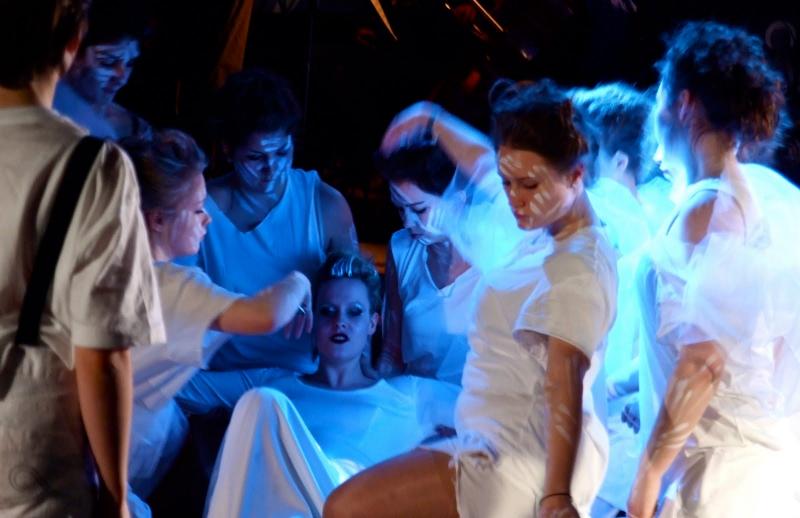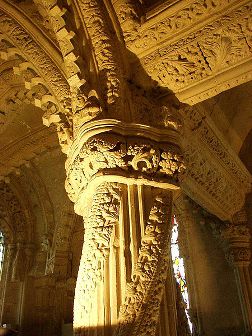Britten's A Midsummer Night's Dream, Shadwell Opera, Rosslyn Chapel | reviews, news & interviews
Britten's A Midsummer Night's Dream, Shadwell Opera, Rosslyn Chapel
Britten's A Midsummer Night's Dream, Shadwell Opera, Rosslyn Chapel
Brave student shot at Britten's elaborate opera in a magical setting

Forget Dan Brown’s phony grail trail which has led so many paying pilgrims to Rosslyn outside Edinburgh. For the last week of the Festival Fringe the Chapel, most intricate and mysterious of 15th-century sanctuaries, has become a temple of high art dedicated to Mozart, Shakespeare and Britten. Ambitious indeed of a bunch of Cambridge undergrads and alumni to mount The Magic Flute and the operatic Midsummer Night’s Dream side by side. Did they pull it off?
First, certainly, find your singers – which they had, and cast them mostly well, too - but perhaps also make sure you have an orchestra of virtuosi. And here the brave attempt to find an ad hoc group of musicians prepared to come from all corners to play for free nearly sank the enterprise. The composer would not, perhaps, have recognised the aleatorics that bedevilled whole stretches of the score.
Conductor Aidan Coburn held it all admirably together, but there were gaps in the texture where the cadenzaing woodwind went missing. I didn’t quite hear the soughing of the boughs in what should have been those primeval string glissandi at the beginning – though at least the forest of Rosslyn’s elaborate pillars established some kind of spell. And poor Puck’s trumpet never did quite get on the highwire. Fortunately his stage incarnation, Cambridge PhD student and DJ Ssegewa-Ssekintu Kiwanuka (pictured below right), had all the charisma needed for a new take on Robin Goodfellow very different from the pubescent boy Britten envisaged.
 Though this is not a singing role, Kiwanuka used his voice strikingly through several octaves. He could teach many of the nice young singers a thing or two about projection, focus and the power of stillness. You couldn’t escape the feeling sometimes that these were sophisticated choral scholars come home to roost in a chapel, for the true operatic welly needed to keep Britten’s brink-of-pallid writing for Shakespeare’s four young lovers didn’t often kick in. They looked good, though, especially in their underwear, and Rachel Bagnall’s Helena had something of the energy needed. A bit more work on the text might have helped in the difficult Act Two quarrel.
Though this is not a singing role, Kiwanuka used his voice strikingly through several octaves. He could teach many of the nice young singers a thing or two about projection, focus and the power of stillness. You couldn’t escape the feeling sometimes that these were sophisticated choral scholars come home to roost in a chapel, for the true operatic welly needed to keep Britten’s brink-of-pallid writing for Shakespeare’s four young lovers didn’t often kick in. They looked good, though, especially in their underwear, and Rachel Bagnall’s Helena had something of the energy needed. A bit more work on the text might have helped in the difficult Act Two quarrel.
Top vocal quality came from the fairy consorts. Maud Millar’s Tytania proved queenly and economical of gesture – another object lesson to many in the cast for what to do with their hands – while weaving some gorgeous upper-register spookiness, and Tom Verney’s counter-tenor Oberon suggested latent anger behind his fine-spun lines.
For mechanicals, read students doing hempen-homespun. Tristan Hambleton is an elegant baritone, aristocratic of phrase, hardly a natural Bottom. His fellow rustics had the mugs, sometimes overdid the mugging and raised many of the necessary laughs in the very tragical comedy of Pyramus and Thisbe, not least Edward Leach’s gurning moon/ Snout. In this production by Jack Furness and Imogen Tedbury, their Elizabethan garb clashed – apparently was meant to, though I’m still not quite sure why – with supposedly post-rave lovers (they looked Victorian to me - and why the blond wig for Helena?), silk-dressing-gowned and angry Theseus and Hippolyta and the white, mirrored world of the fairies. Furness and Tedbury had replaced Britten’s innocent/ corrupt boy sprites with candyfloss-haired maidens singing divinely and writhing Isadoraishly.
 That they did too often, perhaps, and too many were crowded onto the very small platform beneath Rosslyn’s virgin. The onstage witching should surely have been left, for the most part, to the four excellent mid-teen leaders. Then, perhaps, it might not have seemed so random, along with the mysteriously roving spotlights which often appeared to be evading their targets.
That they did too often, perhaps, and too many were crowded onto the very small platform beneath Rosslyn’s virgin. The onstage witching should surely have been left, for the most part, to the four excellent mid-teen leaders. Then, perhaps, it might not have seemed so random, along with the mysteriously roving spotlights which often appeared to be evading their targets.
Something of the clarity which finally struck, both orchestrally and vocally, in the lovers’ awakening might have been brought to bear throughout: less is more always seems a difficult maxim for students to adopt. All credit to the Cantabrians, though, for their skill in occupying the still partly under-wraps chapel (the legendary Apprentice's Pillar pictured above): this has to be the most evocative of all festival venues, surely. Full marks, too, to their powers of organisation and their well-deserved sell-out run.
- Two more Rosslyn Chapel performances of A Midsummer Night's Dream on 26 and 28 August, alternating with The Magic Flute
- Further details on Shadwell Opera's website
The future of Arts Journalism
You can stop theartsdesk.com closing!
We urgently need financing to survive. Our fundraising drive has thus far raised £49,000 but we need to reach £100,000 or we will be forced to close. Please contribute here: https://gofund.me/c3f6033d
And if you can forward this information to anyone who might assist, we’d be grateful.

Subscribe to theartsdesk.com
Thank you for continuing to read our work on theartsdesk.com. For unlimited access to every article in its entirety, including our archive of more than 15,000 pieces, we're asking for £5 per month or £40 per year. We feel it's a very good deal, and hope you do too.
To take a subscription now simply click here.
And if you're looking for that extra gift for a friend or family member, why not treat them to a theartsdesk.com gift subscription?
more Opera
 La bohème, Opera North review - still young at 32
Love and separation, ecstasy and heartbreak, in masterfully updated Puccini
La bohème, Opera North review - still young at 32
Love and separation, ecstasy and heartbreak, in masterfully updated Puccini
 Albert Herring, English National Opera review - a great comedy with depths fully realised
Britten’s delight was never made for the Coliseum, but it works on its first outing there
Albert Herring, English National Opera review - a great comedy with depths fully realised
Britten’s delight was never made for the Coliseum, but it works on its first outing there
 Carmen, English National Opera review - not quite dangerous
Hopes for Niamh O’Sullivan only partly fulfilled, though much good singing throughout
Carmen, English National Opera review - not quite dangerous
Hopes for Niamh O’Sullivan only partly fulfilled, though much good singing throughout
 Giustino, Linbury Theatre review - a stylish account of a slight opera
Gods, mortals and monsters do battle in Handel's charming drama
Giustino, Linbury Theatre review - a stylish account of a slight opera
Gods, mortals and monsters do battle in Handel's charming drama
 Susanna, Opera North review - hybrid staging of a Handel oratorio
Dance and signing complement outstanding singing in a story of virtue rewarded
Susanna, Opera North review - hybrid staging of a Handel oratorio
Dance and signing complement outstanding singing in a story of virtue rewarded
 Ariodante, Opéra Garnier, Paris review - a blast of Baroque beauty
A near-perfect night at the opera
Ariodante, Opéra Garnier, Paris review - a blast of Baroque beauty
A near-perfect night at the opera
 Cinderella/La Cenerentola, English National Opera review - the truth behind the tinsel
Appealing performances cut through hyperactive stagecraft
Cinderella/La Cenerentola, English National Opera review - the truth behind the tinsel
Appealing performances cut through hyperactive stagecraft
 Tosca, Royal Opera review - Ailyn Pérez steps in as the most vivid of divas
Jakub Hrůša’s multicoloured Puccini last night found a soprano to match
Tosca, Royal Opera review - Ailyn Pérez steps in as the most vivid of divas
Jakub Hrůša’s multicoloured Puccini last night found a soprano to match
 Tosca, Welsh National Opera review - a great company reduced to brilliance
The old warhorse made special by the basics
Tosca, Welsh National Opera review - a great company reduced to brilliance
The old warhorse made special by the basics
 BBC Proms: The Marriage of Figaro, Glyndebourne Festival review - merriment and menace
Strong Proms transfer for a robust and affecting show
BBC Proms: The Marriage of Figaro, Glyndebourne Festival review - merriment and menace
Strong Proms transfer for a robust and affecting show
 BBC Proms: Suor Angelica, LSO, Pappano review - earthly passion, heavenly grief
A Sister to remember blesses Puccini's convent tragedy
BBC Proms: Suor Angelica, LSO, Pappano review - earthly passion, heavenly grief
A Sister to remember blesses Puccini's convent tragedy
 Orpheus and Eurydice, Opera Queensland/SCO, Edinburgh International Festival 2025 review - dazzling, but distracting
Eye-popping acrobatics don’t always assist in Gluck’s quest for operatic truth
Orpheus and Eurydice, Opera Queensland/SCO, Edinburgh International Festival 2025 review - dazzling, but distracting
Eye-popping acrobatics don’t always assist in Gluck’s quest for operatic truth

Add comment